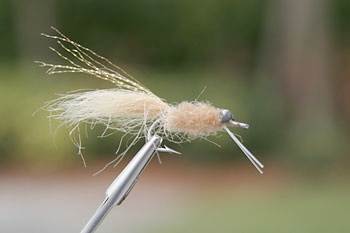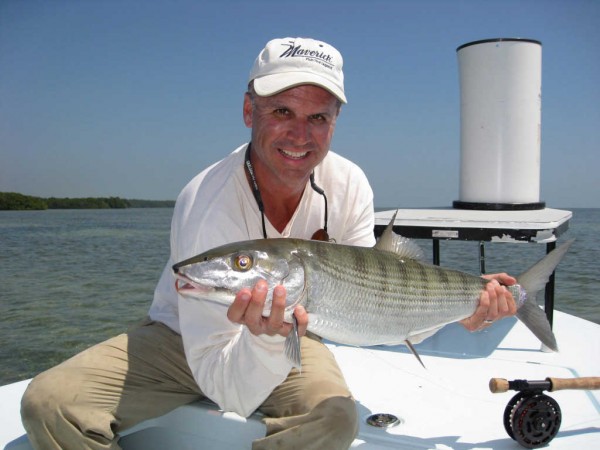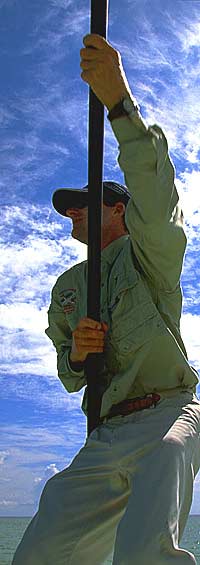Tim: “I get asked a lot about the type of equipment that I use. It is amazing how much time and effort fly fisherman put into analyzing and talking about equipment. I did too, years ago when I was stuck in Chicago practice casting in two feet of snow, blowing 20 and 20 below. I used to build rods, tie flies, go to the fishing shows, watch all the fishing shows, all the normal stuff you do when stuck in front of the fire place.
Now, all I want to do is fish. So, I don’t worry about equipment anymore. I don’t really even experiment with it. All of my rod and reel combos are matching, so when I switch weights the actions are all the same and the reel works the same way. I’ve seen competitive anglers show up at tournaments with two or three different rod reel combos, different rod actions, and different reel manufacturers. Some reels have the drag nobs on the left, some on the right.
One of the main keys is to find what you like, what works for you, and then multiply it so you can be consistent. This helps take equipment mistakes and failures out of the equation.”
The following is a break down of the key components Tim uses everyday while flats tournament fishing:
Boat
I fish out of a 17-foot Mirage. In fact, it is the first Varis built Mirage that Maverick built. I have it matched with a 115 hp 2 stroke Yamaha. For what I do day in and day out, this combo can’t be beat. The Mirage is the quietest boat on the market. There is zero hull slap even in the strongest winds. Most giant bones never know we are there, even from 20-feet away. Also, for tournament fishing, the 115 hp Yamaha gives me the speed to move around quickly. I can run my boat from the Lorelei to Stiltsville in less than 1 1/2 hours. We can be fishing the Shark River area for tarpon and make a move to Key Largo if need be.
Not coincidently, the guides I fish with are Captains Mark Krowka, Rick Murphy, Duane Baker and Eric Herstadt, all fish in Mirages. More impressively, all of us have stayed with this boat for years, even when some said that it was more fashionable to make a move to another manufacturer. The simple reason for this is performance.
Reels
The key to reel selection is pretty simple: buy the most reel you can afford. I fish all older model Abels. 4N Rapid Retrieves for my 9 and 10 weights, and 4.5 Rapid Retrieves for my 12 weights. Large arbor is very important, and of course picking a reel with the classic large cork drag is essential. I love the silent, Seamaster like silent outgoing clicker the Abels give me, but, there are many great choices in this category including Tibor.
Rods
This is a very personal choice. Rod selection should be matched to casting style. I like a fast action rod for my 9- and 10-weights, and thus use Loomis GLX two piece rods. I never take my rods apart therefore I prefer the two piece. For my 12-weights, last year I switched to the Loomis Pro one piece rods for my tarpon fishing. This rod has a powerful butt section for fighting fish but has a lighter tip when delicate presentations are necessary.
The choices for rods are mind boggling, and spending $750 isn’t necessary. Remember, most manufacturers’ second or third rated rod was their premium rod five years ago.
Lines
I exclusively use Monic’s Tropical Clear Fly Line for all of my fishing that targets bonefish, permit, redfish, and snook. I also use it in clear water, calm situations for tarpon on the ocean. I’ve said for years that Monic gives me an extra fish or two a day, and in a tournament, this can make the difference between winning and losing.
Using Monic takes practice and commitment to learn to cast it effectively. Because it is clear, you can’t see it. You can’t see it in the air, nor can you see it on the water. It is soft and will have a different feel altogether versus what you are currently fishing. Fishing it will make you a better fisherman because it will make you focus on looking at the fish’s reaction. Remember, in the end, it’s all about how many fish you catch, not about how you looked doing it.
Leaders
I use 100% flurocarbon leaders, 12- to 18-feet in length depending on the wind. Fluorocarbon sinks better than mono and has more abrasion resistance. My simple leader formula for my 9- and 10-weights are: 6-feet 50-pound butt, 3-feet 30-pound, 2-feet 20-pound, 15-pound tippet . . . adjusted accordingly.
Flies – The primary concern for fly selection is the weight of the fly

Duane Baker’s crab fly travels well. It’s a big bone attractor and out-fishes in the Keys, Biscayne Bay, Bahamas, Belize, and Los Roques. Photo probably by Ford?
Years ago, Tim Borski looked into my fly box during a Redbone Tournament and was shocked. I guess he expected some sort of elaborate selection. I remember Tim asking me: “that’s it?” I think that might have been an insult, and if you ever look into his beautiful box of creations I know you would understand.
For targeting giant bonefish and in the bonefish Invitational Tournaments I fish three fly patterns: brown Merkin, brown Duane Crab (toad), and the Red Headed Step Child (reddish brown colored Gotcha that I use for catching smaller, “release” bones). Flies are tied on size 1- or 2 Mustad 3407s. Color doesn’t matter, as long as it is brown. Simple, 2nd grade stuff. The primary concern for fly selection is the weight of the fly.
Sunglasses
I use one color of polarized sunglasses, Costa Del Mar’s vermillion that I put into a Bolle skier frame that has leather sun blocking side shields.
Boat Accessories
All the Mirages that I fish on are equipped similarly with Pro Trim front casting platforms and stripping baskets. I love the size of their platform which allows me to comfortably move around as well as place the basket up with me on the platform.
So that is it. Now you know what goes into my boat on tournament day. I try to take the old adage, “keep it simple stupid” to the extreme. Take the equipment worries out of picture and work on simplification and duplication. This will allow you to focus on what we are all trying to accomplish – catching more fish!

This fly, a version of Duane’s big bone attractor, works best on smaller bones and it too travels well. Photo probably by Ford.
Now, all I want to do is fish. So, I don’t worry about equipment anymore. I don’t really even experiment with it. All of my rod and reel combos are matching, so when I switch weights the actions are all the same and the reel works the same way. I’ve seen competitive anglers show up at tournaments with 2 or 3 different rod reel combos, different rod actions, and different reel manufacturers. Some reels have the drag nobs on the left, some on the right.
One of the main keys is to find what you like, what works for you, and then multiply it so you can be consistent. This helps take equipment mistakes and failures out of the equation.
Tim writes a blog for Maverick Boats called Tournament Trails




